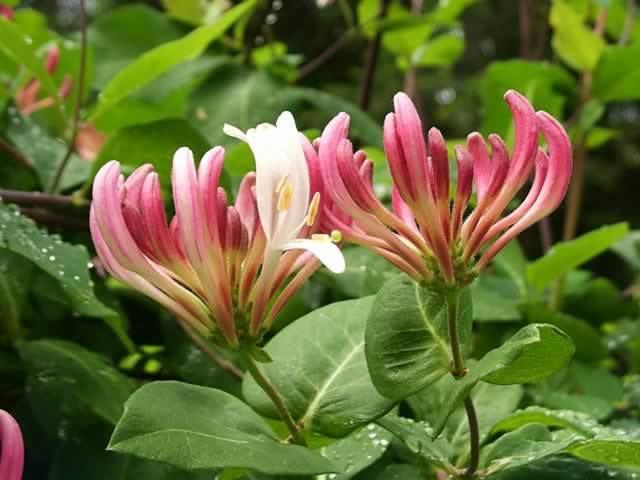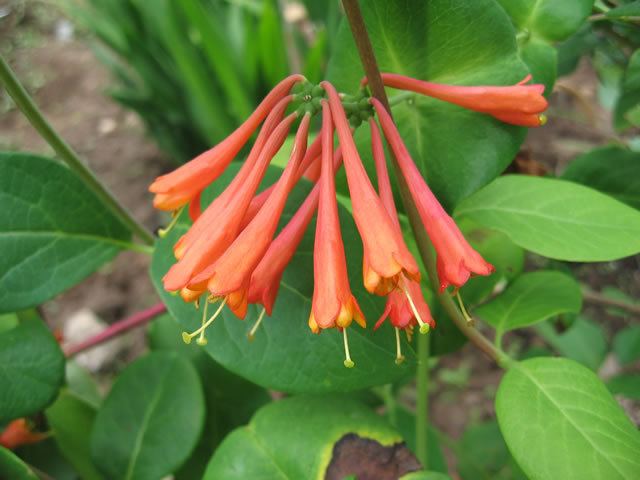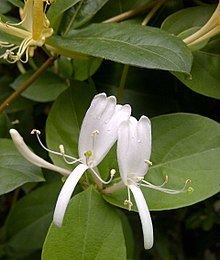Scientific name Lonicera | Rank Genus | |
 | ||
Lower classifications | ||
Bush honeysuckles identification of the wisconsin invasive species lonicera spp
Honeysuckles (Lonicera, /lɒˈnɪsərə/; syn. Caprifolium Mill.) are arching shrubs or twining bines in the family Caprifoliaceae, native to the Northern Hemisphere. Approximately 180 species of honeysuckle have been identified. About 100 of these species can be found in China and approximately 20 native species have been identified in Europe, 20 in India, and 20 in North America. Widely known species include Lonicera periclymenum (honeysuckle or woodbine), Lonicera japonica (Japanese honeysuckle, white honeysuckle, or Chinese honeysuckle) and Lonicera sempervirens (coral honeysuckle, trumpet honeysuckle, or woodbine honeysuckle). hummingbirds are attracted to the flowers on some of these plants, especially L. sempervirens and L. ciliosa (orange honeysuckle). Honeysuckle gets its name because edible sweet nectar can be sucked from the flowers. The name Lonicera stems from Adam Lonicer, a Renaissance botanist.
Contents
- Bush honeysuckles identification of the wisconsin invasive species lonicera spp
- Honeysuckles
- Description
- Invasive species
- Cultivation
- Formerly placed here
- References

Honeysuckles
Description

Most species of Lonicera are hardy twining climbers, with a large minority of shrubby habit; a handful of species (including Lonicera hildebrandiana from the Himalayan foothills and L. etrusca from the Mediterranean) are tender and can only be grown outside in subtropical zones. The leaves are opposite, simple oval, 1–10 cm long; most are deciduous but some are evergreen. Many of the species have sweetly scented, bilaterally symmetrical flowers that produce a sweet, edible nectar, and most flowers are borne in clusters of two (leading to the common name of "twinberry" for certain North American species). Both shrubby and vining sorts have strongly fibrous stems which have been used for binding and textiles. The fruit is a red, blue or black spherical or elongated berry containing several seeds; in most species the berries are mildly poisonous, but in a few (notably Lonicera caerulea) they are edible and grown for home use and commerce. Most honeysuckle berries are attractive to wildlife, which has led to species such as L. japonica and L. maackii spreading invasively outside of their home ranges. Many species of Lonicera are eaten by the larvae of some Lepidoptera species — see a list of Lepidoptera that feed on honeysuckles.
Invasive species

Several species of honeysuckle have become invasive when introduced outside their native range, particularly in New Zealand and the United States. invasive species include L. japonica, L. maackii, L. morrowii, and L. tatarica.
Cultivation
Honeysuckles are valued as garden plants, for their ability to cover unsightly walls and outbuildings, their profuse tubular flowers in summer, and the intense fragrance of many varieties. The hardy climbing types need their roots in shade, and their flowering tops in sunlight or very light shade. Varieties need to be chosen with care, as they can become substantial.
The following hybrids have gained the Royal Horticultural Society's Award of Garden Merit:
Other cultivars are dealt with under their species names.
